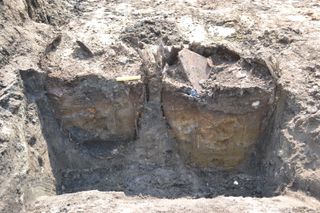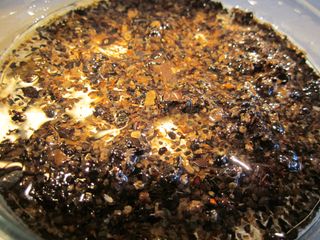These 2 Wine Barrels Were Used As Bathrooms During the Renaissance

After drinking the last drops of wine from two gigantic barrels about 300 years ago, someone had the brilliant idea of repurposing the vats into something down to earth … or rather, in the earth: They stuck the empty barrels in the ground and turned them into toilets.
Archaeologists recently discovered the Renaissance-era latrines (and all of their poopy contents) in Copenhagen during an excavation ahead of a repaving construction project. The makeshift bathrooms, which had been placed in the backyard of a city house, dated to the late 1680s, the archaeologists found.
Many people would flinch at the sight of a 300-year-old toilet, but the archaeologists couldn't believe their luck. They got to work sieving and examining the organic matter, which offered clues about the diets, trade alliances and habits of the people who sat on these johns so long ago. [Through the Years: A Gallery of the World's Toilets]
"The people whose latrines we have investigated were well-fed on bread, fish and meat, alongside a variety of fruit, herbs and spices," said lead study researcher Mette Marie Hald, a senior researcher of environmental archaeology at The National Museum of Denmark.
"Most of the food items were locally grown," she added, "but some of the food plants were exotics, showing us that it was possible to buy, for instance, cloves, which would have come all the way from Indonesia."

The mere presence of these cloves indicates that Copenhageners had access to goods from long-distance trade, probably through the Dutch trading companies, as Indonesia was a Dutch colony at the time, Hald said.
"We know that Dutch traders lived in Copenhagen in the 1680s," she noted. "It's fun to think of the fact that 300 years ago, we were already part of a global trading network."
Sign up for the Live Science daily newsletter now
Get the world’s most fascinating discoveries delivered straight to your inbox.
After digging through the samples, the scientists used microscopes — and, if the objects were big enough, their bare eyes — to label what had passed through the people's innards during the Renaissance. One thing was certain: Whoever used the toilets had a healthy and varied diet. An analysis of the animal bones and plant seeds revealed that the people had eaten their fill of herring and rye bread.
They were also able to buy other types of fish, such as eel, cod and perch, as well as a medley of fruits and herbs, including apples, raspberries, cherries, dill and coriander, she said.
"Some fruits that came from farther away were probably dried, like figs and raisins and lemon peels," Hald told Live Science in an email. "They came from the Mediterranean region and would have been dried in order not to rot on the way up north."
The outhouse also served as a trash can for kitchen scraps, which explains why it contained bones from pigs and cattle, Hald said. "We also found one cat bone, which doesn't mean that cats were eaten, but probably somebody threw a dead cat in the barrel when sweeping the backyard," she said.
But though the inhabitants ate well, they didn't always cook their food enough. A microscopic examination turned up several types of parasites in the latrines. These parasites "would have come from undercooked food and people not washing their hands and infecting the food," Hald said. However, this wasn't uncommon during that time.
"Parasite infections were quite common in the day," Hald said. And, even with the parasites, "our study shows that the diet of 1680s Copenhageners was really quite sophisticated," she said.
The study is published in the August issue of the Journal of Archaeological Science: Reports.
Original article on Live Science.

Laura is the archaeology and Life's Little Mysteries editor at Live Science. She also reports on general science, including paleontology. Her work has appeared in The New York Times, Scholastic, Popular Science and Spectrum, a site on autism research. She has won multiple awards from the Society of Professional Journalists and the Washington Newspaper Publishers Association for her reporting at a weekly newspaper near Seattle. Laura holds a bachelor's degree in English literature and psychology from Washington University in St. Louis and a master's degree in science writing from NYU.
